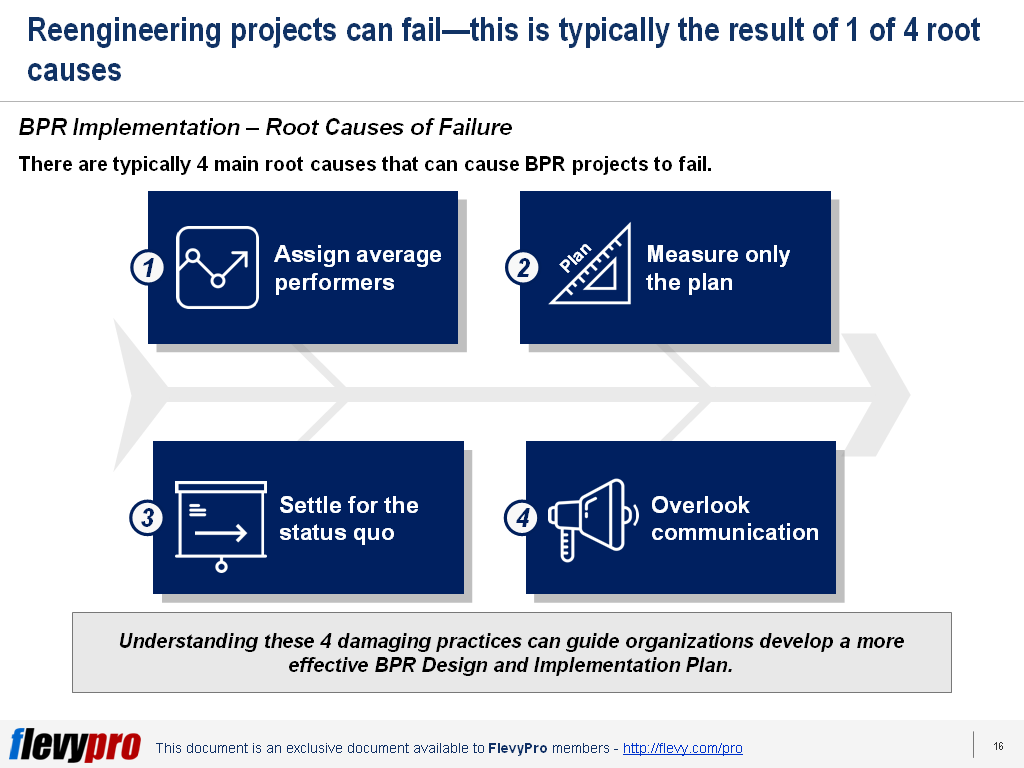Editor's Note: Take a look at our featured best practice, Organizational Velocity - Improving Speed, Efficiency & Effectiveness of Business (47-slide PowerPoint presentation). Lack of efficiency and effectiveness in an organization can have a significant impact on the overall cost of operation.
Organizational Velocity - Improving Speed, Efficiency & Effectiveness of Business provides a framework for diagnosing, assessing and implementing to improve the speed at which [read more]
Also, if you are interested in becoming an expert on Process Improvement, take a look at Flevy's Process Improvement Frameworks offering here. This is a curated collection of best practice frameworks based on the thought leadership of leading consulting firms, academics, and recognized subject matter experts. By learning and applying these concepts, you can you stay ahead of the curve. Full details here.
* * * *
Business Process Reengineering (BPR) can be a great success but it can also be a great failure.
After months or years of careful redesign, organizations can achieve dramatic improvements in individual processes. However, a paradoxical outcome has become almost a commonplace. Organizations suddenly find themselves watching the overall results decline. Process costs were reduced by 34% yet operating income stalls. Claims process time cut by 44% yet profits drop. It seems that organizations are squandering management attention and other resources on projects that look like winners but fail to produce bottom-line results for the business unit as a whole.
Reengineering can actually deliver revolutionary process improvements and many organizations have been undertaking major reengineering effort. However, like any major change program, a reengineering project can produce lasting results only if it is designed and implemented the right way.
Implementing Business Process Reengineering
BPR implementation is a series of waves that can wash over the organization for years, leaving a system for continuous improvement. It must be undertaken with a clean slate approach to process design. Only then can companies avoid a classic reengineering pitfall of focusing on fixing the status quo.
Implementation of the Business Process Reengineering requires that new infrastructures are planned and built to support this Business Transformation. The full commitment of senior executives on its redesign and implementation must also be present to ensure the success of the reengineering project.
It is essential that organizations have a good understanding of the success factors, as well as root causes of failure. While reengineering projects can succeed, it can also fail. There are 4 practices that are the most damaging.
The 4 Root Causes of Failure
The root causes of failure remain a challenge for organizations. These are 4 causes they must watch out for to achieve a successful BPR implementation.
- Assign average performers. This is the tendency of organizations to enlist average performers from headquarters. This often happens because of an existing belief that assigning top performers will affect the business unit’s performance.
- Measure only the plan. Measuring only the plan happens when there is a lack of a comprehensive measurement system. The organization also fails to track whether the implementation is succeeding or failing.
- Settle for the status quo. Settling for the status quo is a very deadly decision or reaction. When this happens, aspirations are never translated into reality. There exists the inability to think outside existing skill levels, organizational structure, or system constraints. Further contributing to this is the existence of political infighting on incentives and information technology during implementation. When this exists, often the decision is to maintain a status quo that could be debilitating to the organization.
- Overlook communication. During BPR implementation, there is a tendency to overlook communication. Probably due to a lack of proper understanding, the level of communication is underestimated during implementation. Often, communication is done using memos, speeches, or PR videos. While these may have its purpose, at times these methods can be limiting.
BPR implementation requires a small group format where employees can give feedback and air their concerns. This may be time-consuming but it is important. In fact, organizations must create a comprehensive communication program that uses a variety of methods of communication. When this is undertaken, the chances of succeeding during the BPR implementation is high.
BPR implementation is most crucial. Hence, organizations must have a keen eye, as well as strong leadership development and commitment, to pursue it despite its challenges. BPR implementation is a series of waves that can wash over the organization for years. Hence, a system of continuous improvement must be in place.
Interested in gaining more understanding of Business Process Reengineering (BPR) Implementation Guidelines? You can learn more and download an editable PowerPoint about Business Process Reengineering (BPR) Implementation Guidelines here on the Flevy documents marketplace.
Do You Find Value in This Framework?
You can download in-depth presentations on this and hundreds of similar business frameworks from the FlevyPro Library. FlevyPro is trusted and utilized by 1000s of management consultants and corporate executives. Here’s what some have to say:
“My FlevyPro subscription provides me with the most popular frameworks and decks in demand in today’s market. They not only augment my existing consulting and coaching offerings and delivery, but also keep me abreast of the latest trends, inspire new products and service offerings for my practice, and educate me in a fraction of the time and money of other solutions. I strongly recommend FlevyPro to any consultant serious about success.”
– Bill Branson, Founder at Strategic Business Architects
“As a niche strategic consulting firm, Flevy and FlevyPro frameworks and documents are an on-going reference to help us structure our findings and recommendations to our clients as well as improve their clarity, strength, and visual power. For us, it is an invaluable resource to increase our impact and value.”
– David Coloma, Consulting Area Manager at Cynertia Consulting
“As a small business owner, the resource material available from FlevyPro has proven to be invaluable. The ability to search for material on demand based our project events and client requirements was great for me and proved very beneficial to my clients. Importantly, being able to easily edit and tailor the material for specific purposes helped us to make presentations, knowledge sharing, and toolkit development, which formed part of the overall program collateral. While FlevyPro contains resource material that any consultancy, project or delivery firm must have, it is an essential part of a small firm or independent consultant’s toolbox.”
– Michael Duff, Managing Director at Change Strategy (UK)
“FlevyPro has been a brilliant resource for me, as an independent growth consultant, to access a vast knowledge bank of presentations to support my work with clients. In terms of RoI, the value I received from the very first presentation I downloaded paid for my subscription many times over! The quality of the decks available allows me to punch way above my weight – it’s like having the resources of a Big 4 consultancy at your fingertips at a microscopic fraction of the overhead.”
– Roderick Cameron, Founding Partner at SGFE Ltd
“Several times a month, I browse FlevyPro for presentations relevant to the job challenge I have (I am a consultant). When the subject requires it, I explore further and buy from the Flevy Marketplace. On all occasions, I read them, analyze them. I take the most relevant and applicable ideas for my work; and, of course, all this translates to my and my clients’ benefits.”
– Omar Hernán Montes Parra, CEO at Quantum SFE

139-slide PowerPoint presentation
Our business process improvements methodology BPI 7 is a proven and systematic approach to continuously improve an organization's existing business processes.
The Business Process Improvement (BPI 7) Training Module includes:
1. MS PowerPoint Presentation including 141 slides covering
[read more]
Want to Achieve Excellence in Process Improvement?
Gain the knowledge and develop the expertise to become an expert in Process Improvement. Our frameworks are based on the thought leadership of leading consulting firms, academics, and recognized subject matter experts. Click here for full details.
Process Improvement involves analyzing and improving existing business processes in the pursuit of optimized performance. The goals are typically to continuously reduce costs, minimize errors, eliminate waste, improve productivity, and streamline activities.
As we continue to deal with COVID-19 and its economic aftermath, most organizations will prioritize Business Process Improvement initiatives. This is true for a few reasons. First, Process Improvement is one of the most common and effective ways of reducing costs. As the global economy slows down, Cost Management will jump to the forefront of most corporate agendas.
Secondly, a downturn typically unveils ineffective and broken business processes. Organizations that once seemed agile and focused during periods of growth may become sluggish and inefficient when demand drops off.
Lastly, COVID-19 has expedited Digital Transformation for most organizations. One of the quickest and most impactful forms of Digital Transformation is Robotic Process Automation (RPA). Thus, we have included numerous RPA frameworks within this Stream.
Learn about our Process Improvement Best Practice Frameworks here.
Readers of This Article Are Interested in These Resources

254-slide PowerPoint presentation
[NOTE: Our Kaizen presentation has been trusted by an array of prestigious organizations, including industry leaders such as Apple, Bayer, University of Michigan, General Motors, Cummins, Baxter, Johnson Controls, Ulta, Daimler Truck, Aramark, Parsons Corporation, to name just a few.]
Explore
[read more]

184-slide PowerPoint presentation
This presentation is a collection of PowerPoint diagrams and templates used to convey 40 different business performance improvement models/frameworks. (Please note that these are diagrams and charts that are to be used in your own business or classroom presentations. These are not instructional
[read more]

41-slide PowerPoint presentation
The Process Automation & Digitalization Assessment is a comprehensive framework designed to help organizations identify opportunities for streamlining operations, reducing manual efforts, and leveraging technology to drive efficiency and scalability. The assessment provides a structured approach to
[read more]

190-slide PowerPoint presentation
The office, by any name, is a paperwork factory. To become a Lean enterprise, office activities must fully support shop-floor manufacturing operations to eliminate waste. The adoption of 5S throughout all office functions is the first step to increase efficiency. 5S principles are dedicated to
[read more]






